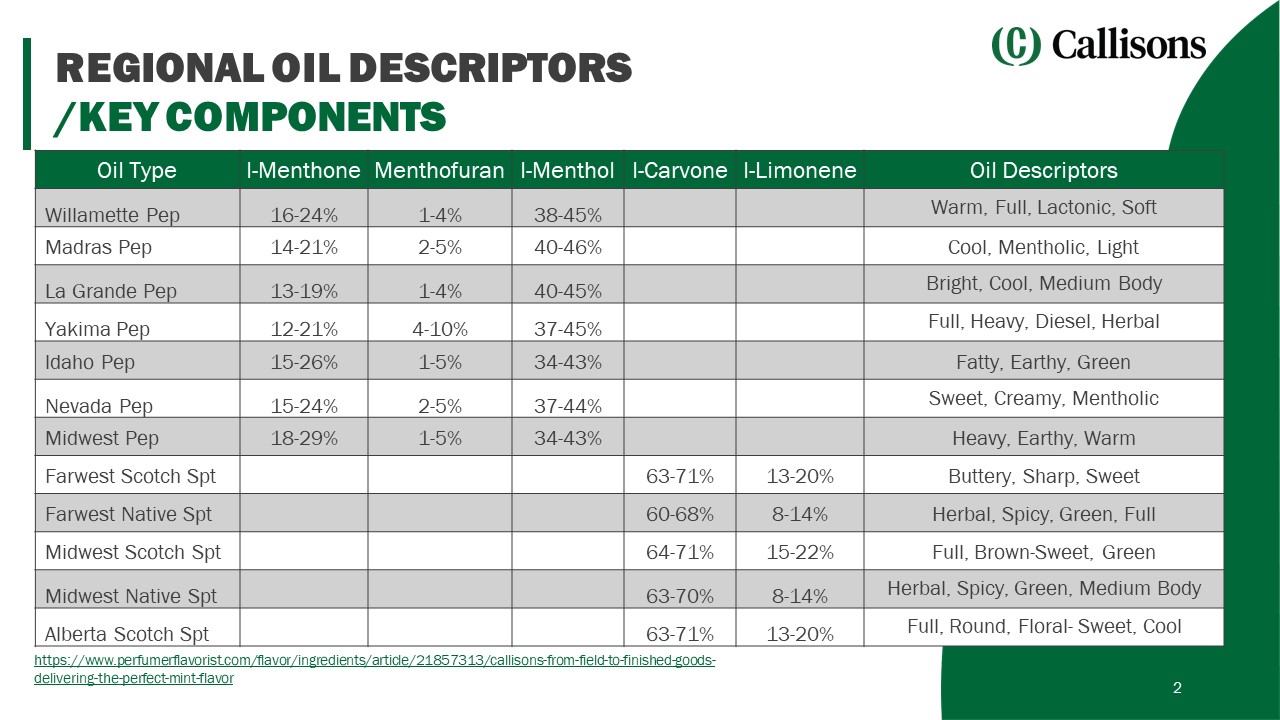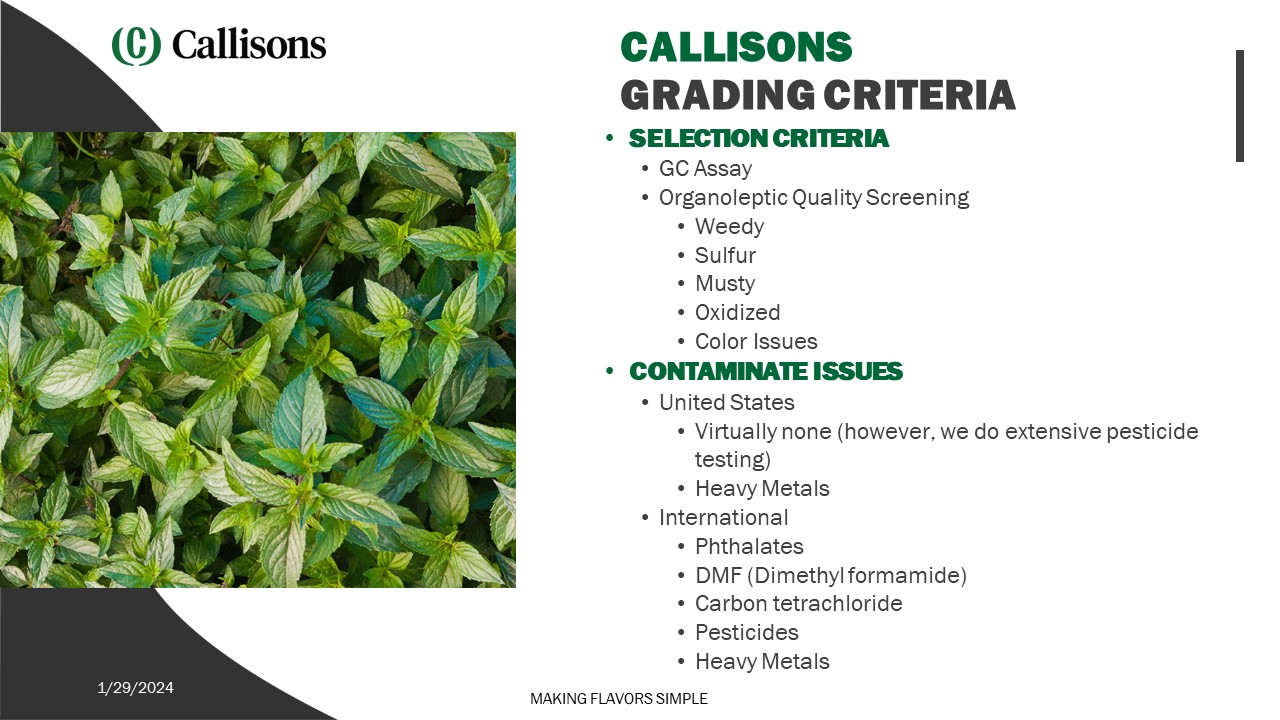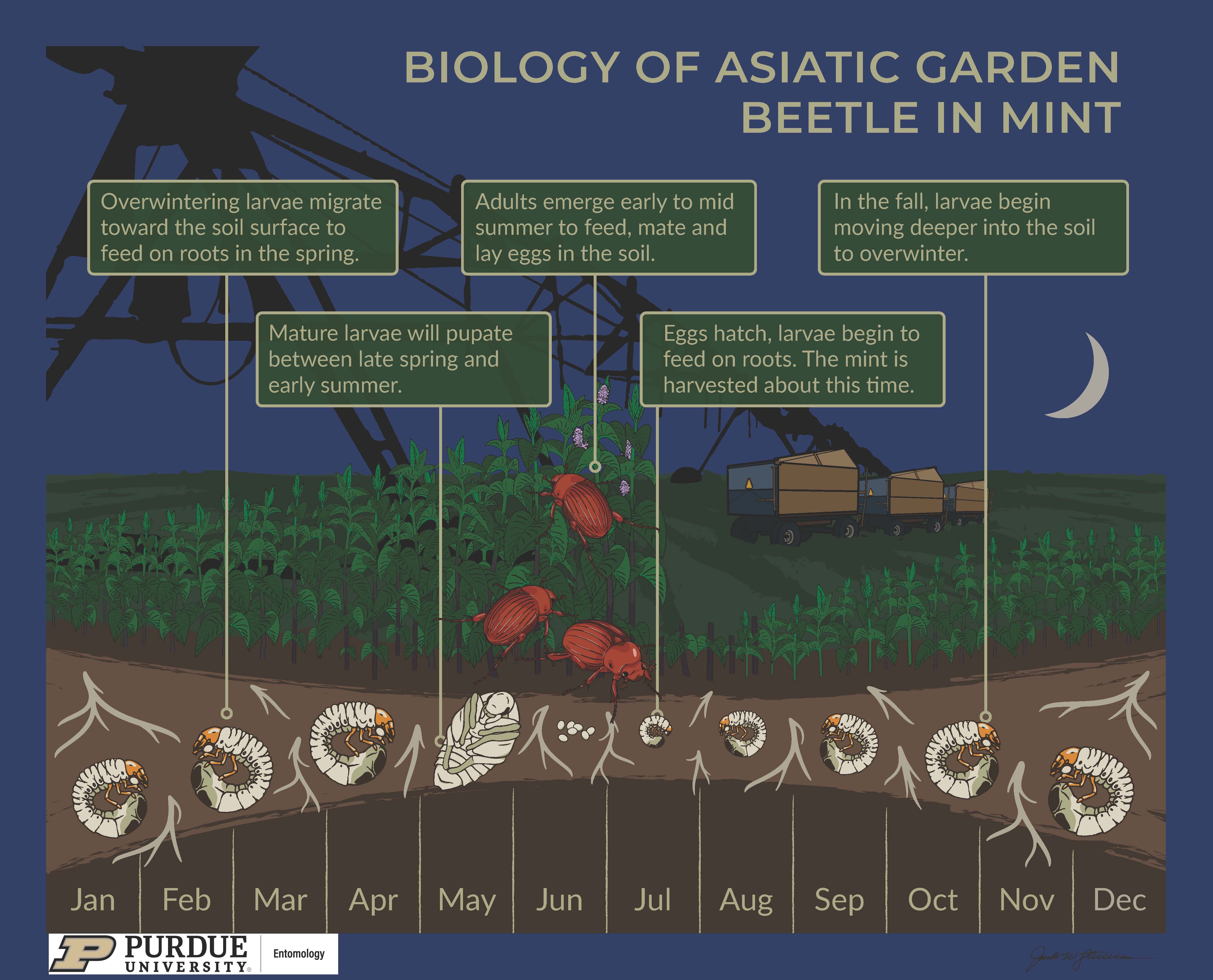Mint Oil Industry Overview

Peppermint and spearmint have been grown in Indiana since the late 1800s. The soils and climate of northern Indiana are well-suited for mint production. For many years, this area, southern Michigan and southern Wisconsin was the major production area of the U.S. After the 1950s, mint acreage increased rapidly in Oregon and Washington, and that area is now the major mint-producing region in the United States. However, Indiana and Wisconsin remain important mint-producing states in the Midwest.
The mints are grown for the essential oils produced in specialized glands on the leaves and stems. This oil is readily recovered by steam distillation of the harvested hay. Peppermint and spearmint oils are widely used to flavor chewing gum, candy, pharmaceuticals, toothpaste, and other oral hygiene products.
In recent years, peppermint and Scotch spearmint mint acreage have decreased in Indiana and the Midwest. Compared to 2021, the 2022 Midwest peppermint, Native and Scotch spearmint acreage declined by 15.2%, 41.5%, and 46.2%, respectively. Total production in the Midwest was 604,000 pounds of oil.
Rising production costs, flatlined pricing, and cheaper imported oil significantly impacted acreage. Forward contracts with growers are very important to keep acreage in the ground.
Mint Production Resources

The Indiana General Assembly passed legislation in the 1970s that allowed agricultural commodity producers to establish a commodity market development program with producer-led councils. The legislation charges the Dean of Agriculture or his/her designee at Purdue University with the establishment process and administration of check-off funds received through these programs. Programs conducted by these councils may include.
- Market development and research
- Market promotion, education, and public relations; and
- Market information services.
In 1987, Indiana mint growers successfully petitioned the Dean of Agriculture at Purdue University to establish a Mint Market Development & Research Council. The Dean charged the Agricultural Experiment Station (now called the Office of Agricultural Research and Graduate Education) in the college with the administration of the Mint Market Development & Research Council. Mint Council activities include active participation with the national Mint Industry Research Council in addition to hosting an educational Midwest Mint Growers Conference every two years. The Wisconsin mint growers host the annual grower's conference on alternate years. A great team of staff, faculty, and Extension Specialists supports Mint growers in Indiana.

The current IMMDC leadership
Doug Matthys, President
Ed Lambert, Treasurer/Secretary
Josh Lawrence
Gregg Kanne
Dan Gumz
Research projects
Weed Management
Horticulture Crops Weed Science Lab Projects
The Horticulture Crops Weed Science lab conducts field and greenhouse research to evaluate peppermint and weed responses to herbicides. The objective is to find safe and effective herbicides to manage common and troublesome weeds that reduce mint oil yield and quality. The research is a collaboration among the Mint Industry Research Council, the Indiana Mint Marker Development and Research Council, IR-4 Project, and Purdue.
Verticillium Wilt Management
Biological approaches to sustainable mint production
Peppermint is a high-value crop grown for both its desirable oil composition and high yield. However, this crop is highly susceptible to Verticillium wilt, a devastating disease caused by Verticillium dahliae. In response to growers' needs, researchers, extension educators, and growers together formalized a plan to develop research-based information on effective management and control strategies to limit the disease. Therefore, we applied successfully for an NCR-SARE Research and Education grant in 2018.
Verticillium wilt is a vascular disease caused by Verticillium dahliae, a highly prolific soil-borne fungal pathogen that negatively affects mint. There are some chemical fumigants that can control this disease, but they can negatively impact beneficial soil organisms. Biological fumigation using anaerobic soil disinfestation (ASD) is an alternative approach that has been successfully used to control V. dahliae in other crops like strawberries. During the ASD process, a labile carbon amendment is applied to the field, and then the soil is saturated with water and covered with a fumigation tarp for about 4 weeks. The goal of this study is to determine whether ASD can control Verticillium wilt in mint using local carbon substrates to make it economically feasible. The carbon substrates chosen for the study included: chicken litter, dried distiller’s grain from corn, soybean meal, and a Brassica cover crop. The study was initiated during the summer of 2020. During the study, soil samples were collected pre and post-ASD treatment, and quantification of changes in V. dahliae populations. Other soil health metrics, including pH, active soil carbon, mineralizable nitrogen, and microbial activity, were also quantified to determine whether the ASD process could provide other benefits. Finally, the incidence and severity of Verticillium wilt were monitored in the experimental plots, and changes in the biomass and amount of essential oil were quantified at harvest. The project concluded in 2022, and the final project report is available below.
For more information about this project, contact Petrus Langenhoven (plangenh@purdue.edu) or Lori Hoagland (lhoaglan@purdue.edu).
Biological approaches to sustainable mint production
Asiatic Garden Beetle Management
Insect-parasitic nematodes as a sustainable management tool for the Asiatic garden beetle in mint
The Asiatic Garden Beetle (Maladera castanea), hereafter AGB, is a small beetle that attacks more than 100 different plant species, including ornamentals, weedy species, and crop plants. Adult beetles feed on flowers and foliage, but the most severe damage is inflicted by the larval (white grub) stage, which feeds underground on plant roots for nearly 10 months of the year. Feeding damage can lead to water stress, reductions in crop growth and yield, and even plant death. Indiana mint growers have suffered significant losses to their perennial mint crop due to AGB grub damage, making this pest a serious threat to the Indiana mint industry. Limited knowledge of the success and sustainability of chemical and biological control strategies for AGB grubs in mint and the potential influence of soil type on the outcome of these strategies for AGB grubs pose key decision-making challenges for mint growers who are battling this insect. Purdue University entomologists will partner with commercial mint producers in the state to grow our knowledge of this pest and its management in mint systems. The goals of this project are to 1) evaluate the efficacy and persistence of insect-parasitic nematodes against AGB grubs in commercial mint fields and 2) evaluate the influence of soil type and insecticide treatment on the success of insect-parasitic nematode suppression of AGB in mint using laboratory and greenhouse trials. Upon completion, these objectives will contribute to our understanding of sustainable management practices for AGB in Indiana Mint.
Insect-parasitic nematodes as a sustainable management tool for the Asiatic garden beetle in mint
Publications
Tolerance of peppermint to tiafenacil applied postharvest
Simulated dormant peppermint (Mentha x piperita) response to mesotrione: a greenhouse study
2023 Indiana Herbicide Trials - Indiana Mint Market Development and Research Council (IMMDC)
2023 Indiana Herbicide Trials - Mint Industry Research Council (MIRC)
Posters
Peppermint (Mentha x piperita) Response to Thiafenacil Applied Postharvest
Developing sampling plans to estimate asiatic garden beetle damage in commercial mint
Extension Publications
Midwest Vegetable Production Guide - Mint for Oil
Controlling Verticillium Wilt: Indiana Peppermint Growers Top Management Practices
Vegetable insects - Mint Flea Beetle
Biology and Management of Asiatic Garden Beetle in Indiana Mint Production
PODCASTS
Episode #32: Mint Production (for oil)Presentations
Growing Areas
Mint Species Grown
There are two types of mint grown for their essential oils. These are peppermint (Mentha piperita) and two species of spearmint: native or American spearmint (Mentha spicata) and Scotch spearmint (Mentha cardiaca). All of these came originally as selections from native plants, and until the 1970s, there were no commercially developed varieties of any of these species. Presently, there are four varieties of peppermint: Black Mitcham (the original selection from the wild), Todd's Mitcham, Murray Mitcham, and Robert's Mitcham. The last three varieties were developed to reduce losses from the highly destructive disease Verticillium wilt.
The oils from Native and Scotch spearmints are very similar but have different commercial uses. Native spearmint is used most often to flavor toothpaste and dental hygiene products. Scotch spearmint has a milder, more pleasant taste and is used in chewing gum and confections. At present, no new varieties of either type of spearmint are widely grown. Breeding and selection work continues in the development of new varieties.
Soils and nutrition
Mint is shallow-rooted and requires loose-textured soils for good root penetration and growth. It requires abundant moisture during the growing season for optimum growth and relatively high fertility (especially nitrogen).
The high organic (muck) soils found in northern Indiana, Michigan, and Wisconsin are ideal for mint production because they are deep, light soils with a high water table that can be controlled through drainage systems. Some of the moisture demands of mint can be met by controlling the water table, thus reducing the need for irrigation. However, light, well-drained mineral soils are also well suited for mint production, but they may require supplemental irrigation for best growth and oil production. Mineral soils have less than 5% organic matter and varying amounts of humus, silt, sand, and clay.
The optimum soil pH for growing mint is 5.5 to 6.5. To determine base fertility levels, soil tests are done before the mint is planted. Mint requires a phosphorus (P2O5) level of 100 pounds per acre and a potassium (K2O) level of 400 pounds per acre. Nitrogen is usually applied in split applications, the first at crop emergence and the second when plants are 10 to 12 inches tall. The amount of nitrogen varies, but the usual range is 125 to 200 units per acre. The equivalent of 50 pounds of phosphorus and 100 to 150 pounds of potassium is applied each year to maintain optimum fertility. After the first year, these can be applied at fall plowing.
Planting and Stand Maintenance
All commercial mint varieties are seed sterile and are propagated using the underground stolons (runners or rootstock) produced by existing plants. Mint stolons are dug from existing fields or nursery beds established for this purpose. Immediately before planting, dormant stolons are dug with a mechanical digger similar to a potato digger. The stolons cannot be stored for more than a few days since they deteriorate rapidly due to heating or dehydration. The short shelf life of the stolons limits the distance from the source to the new growing area.
Mint is planted in late fall or spring using specially built mechanical planters. The planter cuts the stolons into 3 to 4-inch pieces and drops them into furrows. The furrows are closed and firmed by a packer wheel to ensure good soil contact.
The volume of stolons required to plant an acre of new mint varies with row width, condition of stolons, and other factors. An acre of well-established mint will yield sufficient stolons to plant an average of 10 acres. To establish on-farm nursery beds, new planting stock may also be purchased from a certified producer. This is highly advisable, especially in new growing areas, because a number of serious diseases and insect pests can be introduced on contaminated planting stock from local sources.
In the first-year planting, mint is maintained in 30 to 36-inch rows (with a trend toward narrower rows), but little cultivation is done. Growers rely on herbicides for weed control, and supplemental nitrogen applications are broadcast rather than sidedressed. In the following years, the field is worked lightly before crop emergence to eliminate early weed growth and to facilitate herbicide applications.
Shoots and roots sprout from buds on the stolons in the spring to produce new plants. Crop emergence with row mint depends on the time of planting but is usually mid-April to early May. In the following years, meadow mint crop emergence usually occurs in early to mid-April in mineral soils and later in muck soils.
After harvest, the crop is permitted to regrow to increase stolon production to establish the next year's crop. Because severe winter conditions may damage the crop, it is plowed under in the late fall after one or more killing frosts have induced dormancy. The plowing depth does not exceed 4 to 5 inches, but the stolons and crop debris must be turned clean so they are fully covered by soil.
With "clean plowing," the soil becomes subject to wind erosion in late winter and early spring. Rye is usually drilled in rows or lightly broadcast as a cover crop in muck soils. However, fall plowing is often done too late in mineral soils to establish a fall cover crop, so oats are broadcast in early spring. Growers also spread the crop refuse (after distillation) onto the field for protection against wind erosion. If available, irrigation is often used to limit soil losses by wind and to protect the emerging crop from damage by late spring frosts.
Irrigation
Harvest
Maximum oil yield depends upon both the stage of crop development and favorable environmental conditions. Under favorable weather conditions (bright sunny days with warm temperatures), oil increases rapidly as the plant approaches vegetative maturity; that is when the plant begins to bloom. Optimum oil yield and quality are attained when approximately 10% of a peppermint crop is in full bloom. With the spearmints, harvest begins when all plants are in full bloom. Depending on geographic location, mint is harvested from late June to early September.
Oil yields tend to be slightly higher during the first crop year in row mint, declining somewhat in subsequent years. However, weather conditions impact yield most in any given season.
Mint is cut and windrowed in much the same manner as hay. Typically, mint is cut and windrowed with a swather, although other types of harvest equipment, such as a sickle bar or a rotary windrower, may be used. Mint foliage and stems are allowed to partially dry in windrows in the field for 24 to 48 hours before it is collected for distillation. The field drying process is critical in obtaining maximum oil yield. If the leaves become too dry, they shatter, and oil will be lost. If the mint hay is too green or wet, distillation time is prolonged, and the oil becomes difficult to recover.
The cured mint hay is picked up from the windrow with a field chopper and blown into a portable distillation tub for transport to the distillery. The tubs are equipped with perforated steam lines at the bottom and a closed top so that a steam line and vapor pipe can be attached to the distillery to recover the oil. Depending on yield, a tub generally holds mint harvested from 0.75 to 1.25 acres.
Post-production management
At the end of the four- to five-year rotation, the mint is allowed to regrow after harvest. The hay is cut a second time and distilled. The mint stand is then disked or otherwise "torn up" and left over winter. Generally, there is little problem with volunteer mint growth the next season. Corn commonly follows mint in the crop rotation, and the herbicides used for corn effectively control volunteer mint growth.
Production Resources
Midwest Vegetable Production Guide, page 204
Peppermint Nutrient Management Guide
2024 Indiana Agriculture Overview
Row Mint - first year
February – March
Mint roots (stolons) planted in rows.
March
Cover crop (windbreak) of small grains planted in remaining mineral soils
April
Crop emergence
Preemergence herbicides applied
Nitrogen applied
May
Vegetative growth of spearmint and peppermint
Field scouting takes place for weeds, diseases, and insects
Postemergence herbicides applied, if needed
Applications for mint rust in spearmint, if needed
June
Vegetative growth of peppermint
Spearmint begins to bloom
Postemergence herbicides applied, if needed
Late June – Early July
Spearmint harvest
July
Peppermint begins to bloom
Continued scouting for weeds, diseases, and insects
Early August
Peppermint harvest
Flea beetle control, if needed, within three days of harvest
Late September – October
Killing frost
October
Clean plow (if using conventional tillage) and fertilizer application
November
Cover crop (windbreak) of cereal grains planted in muck soils and some mineral soils
Meadow Mint - two years and older
March
Cover crop (windbreak) of small grains planted in remaining mineral soils
April
Crop emergence
Preemergence herbicides applied
Nitrogen applied
May
Vegetative growth of spearmint and peppermint
Field scouting takes place for weeds, diseases, and insects
Postemergence herbicides applied, if needed
Applications for mint rust in spearmint, if needed
June
Spearmint and peppermint begin to bloom
Postemergence herbicides applied, if needed
Late June
Spearmint harvest
July
Peppermint harvest begins
Continued scouting for weeds, diseases, and insects
Flea beetle control, if needed, within three days of harvest
Late August – Early September
Second cutting from spearmint and peppermint fields being taken out of rotation
Late September – October
Killing frost
October
Clean plow (if using conventional tillage) and fertilizer application
November
Cover crop (windbreak) of cereal grains planted in muck soils and some mineral soils
Mint oil is recovered from the cured mint hay in a mint distillery on the farm. Because distilling must be done in a timely manner, it is almost essential to have a distillery on the farm. Growers with smaller acreages often share a distillery.
The mint distillery consists of a high-pressure steam boiler, portable distillation tubs, a condenser, a receiver, and a redistillation unit. Although some of this equipment can be purchased from manufacturers, much of it is custom-built locally or on the farm. Mint oil is recovered from the hay by applying steam to the distillation tub through a series of perforated pipes on the bottom of the tub. During distillation, the mint oil/steam mixture flows from the tub through a water-cooled condenser and into a receiver, where the mint oil floats on top of the water and is recovered.
Mint oil can be kept for two or more years if it is stored properly to reduce oxidation or heat deterioration. Growers raise mint primarily on contract with mint buyers. During harvest, oil buyers pick up oil almost daily from the growers. Often, growers exceed the amount of oil stipulated in their contract, and in these instances, oil buyers generally store the excess oil for future sales at no charge to the grower.
Mint oil buyers may further refine the oil and blend it for uniform quality before selling it to the end user. Quality standards for odor, taste, color, and freedom from unacceptable residues are very strict and outlined in the contract. Oil failing to meet the specified standards may bring reduced prices or result in termination of the contract.


Resources
Industry
Mint Oil Characterization - Callisons
Publications
New essential oil distillation system design and construction - Year 1
Essential oil extraction process engineering for improved energy efficiency
Videos
Oregon Seed Certification Service
Contact Stephen Meyers (slmeyers@purdue.edu) if you need more information about weed management in mint.
Publications
Midwest vegetable Production Guide - Mint for OilCompendium of Herbicide Adjuvants
Adjuvants and the power of the spray droplet
Mint Bud Mite
The primary insect pests of Midwest mint production are the mint bud mite and the mint flea beetle. The mint bud mite causes a condition called “squirrely mint.” Damage from the mite causes stunting and distortion of the upper plant, and mint oil yields can be reduced by as much as 80%. This damage has been seen mainly on peppermint, but spearmint can also be damaged. Damage is seen on both muck and mineral plantings. The mite is spread by infested rootstock, machinery, and natural conditions. Mint stands with mite infestations on 20% or more of the terminal buds should be treated.
Mint Flea Beetle
Adult flea beetles feed on the lower leaves in the inner canopy, causing little crop damage. However, eggs laid by adults will overwinter on the crown of the plant and in the soil and hatch in spring. The larvae feed on the fine roots and the main underground stem of the mint plant, causing the plants to be stunted and often die. Damage is usually most noticeable in the third year or later of mint stand. Damage to the underground stem also allows secondary infections from soil microorganisms to occur.
Asiatic Garden Beetle
The Asiatic Garden Beetle (Maladera castanea), hereafter AGB, is a small beetle that attacks more than 100 different plant species, including ornamentals, weedy species, and crop plants. Adult beetles feed on flowers and foliage, but the most severe damage is inflicted by the larval (white grub) stage, which feeds underground on plant roots for nearly 10 months of the year. Feeding damage can lead to water stress, crop growth and yield reductions, and even plant death.
Below is an infographic that depicts the seasonal phenology of Asiatic garden beetle (Maladera formosae) larvae and adults in commercial peppermint in Indiana(Purdue Entomology Extension. Illustration by Jack Stevens).

Cropping systems such as planting certified rootstock, crop rotations of four years or less, and fall plowing help to reduce populations of both mint flea beetle and mint bud mite. Regular scouting determines the presence and potential damage of insect pests; insecticides are applied only as needed.
Other pests that cause sporadic damage in mint include mint looper, variegated cutworm, two-spotted spider mite, mint stem borer, mint root borer, and nematodes.
Contact Elizabeth Long (long132@purdue.edu) if you need more information about mint insect pests.
Pest resources
Midwest Vegetable Production Guide, p 204
Verticillium Wilt
Verticillium wilt and mint rust are the two major mint diseases in the Midwest. These are the only two diseases that routinely cause economic damage; however, other pathogens may cause severe losses under certain environmental conditions or management practices.
Verticillium wilt causes plants to be stunted, have smaller, twisted leaves, and drastically reduced oil yields. Infected plants usually die before harvest. A soil-borne fungus causes this disease, which infects the plant through natural openings or wounds on the roots. Verticillium spreads from field to field via diseased planting stock, soil-contaminated equipment, and wind-eroded soil. The fungus persists in the soil for many years regardless of crop rotation or management practices. There is no economically feasible chemical control for Verticillium wilt. Infestation of new growing areas can only be prevented through the use of certified, disease-free planting stock. Peppermint (particularly the cultivar, ‘Black Mitcham’) is most susceptible to Verticillium wilt, while Scotch spearmint is less susceptible, and native spearmint is highly resistant.
Mint rust
Mint rust affects both peppermint and the spearmints in Wisconsin and Michigan, but only spearmint suffers damage in Indiana. Rusted leaves turn brown and drop off the plants resulting in reduced oil yields. Winter survival can be reduced as well. Fall plowing of mint can reduce infestations. Early harvest of Spearmint prevents further damage to the plants and increases chances for overwinter survival, but may result in reduced oil yields.
Other diseases
Other diseases of mint in the Midwest include Septoria leaf spot, Anthracnose (Leopard Spot), and non-specific stolon decline (a complex of Fusarium, Rhizoctonia, Sclerotinia, Alternaria, Phoma, and Pythium). These diseases are sporadic and rarely occur at levels that require control. There are no known diseases affecting Midwest mint caused by viruses or mycoplasma-like organisms.
Contact the Purdue Plant Pest Diagnostic Lab if you need more information about mint diseases.
Disease Resources
Midwest Vegetable Production Guide, p 204
Verticillium Wilt (Verticillium dahliae)
Verticillium Wilt of Mint in the United States of America
Peppermint Pest Management Guidelines: Verticillium Wilt
Evaluation of Verticillium Wilt Resistance in Mentha arvensis and M. longifolia Genotypes
Mint Rust (Puccinia menthae L.)
Peppermint and Spearmint (Mentha spp.) rust
Slow-rusting resistance in native spearmint to Puccinia menthae
Office of Indiana State Chemist
Purdue Pesticide Programs
Pesticide Applicator Training Programs
DriftWatch - Specialty Crop Site Registry
Selected Publications
Understanding the Revised Worker Protection StandardPesticides and Container Management
Pesticides and Personal Protective Equipment
Pesticides and Personal Safety
Tips for Commercial Ag Pesticide Applicators
Removing Herbicide Residues from Ag Application Equipment
Bulk pesticide and fertilizer storage on Indiana Farms
Purdue Institute for Family Business
Purdue Inventure Business Planner
Purdue Center for Commercial Agriculture
Center for Commercial Ag website
Publications
Communications in the FamilyFatal Business Planning Assumptions
Financial Planning for Retirement
Key Decisions for the Farm Business
Goal Setting and Decision Making
A Checklist Guide for New Businesses
Marketing's Four P's
Structuring Small Business
First Steps for New Entrepreneurs
Indiana
Wisconsin
Idaho
Oregon and Washington state
(Willamette and Yakima Valley)
Mint Extension Specialists

Petrus Langenhoven
Mailing Address:
Dr. Petrus Langenhoven
Purdue University
625 Agriculture Mall Dr., West Lafayette, IN 47907

Stephen Meyers
Dr. Stephen Meyers
Purdue University
625 Agriculture Mall Dr., West Lafayette, IN 47907

Elizabeth Long
Dr. Elizabeth Long
Purdue University
901 West State Street, Smith Hall, West Lafayette, IN 47907

Phil Woolery
Phil Woolery
Purdue University
125 S Riverside Drive, Winamac, IN 46996
Agriculture Administration

Meredith Cobb
Meredith Cobb
Purdue University
175 S University Street, West Lafayette, IN 47907



